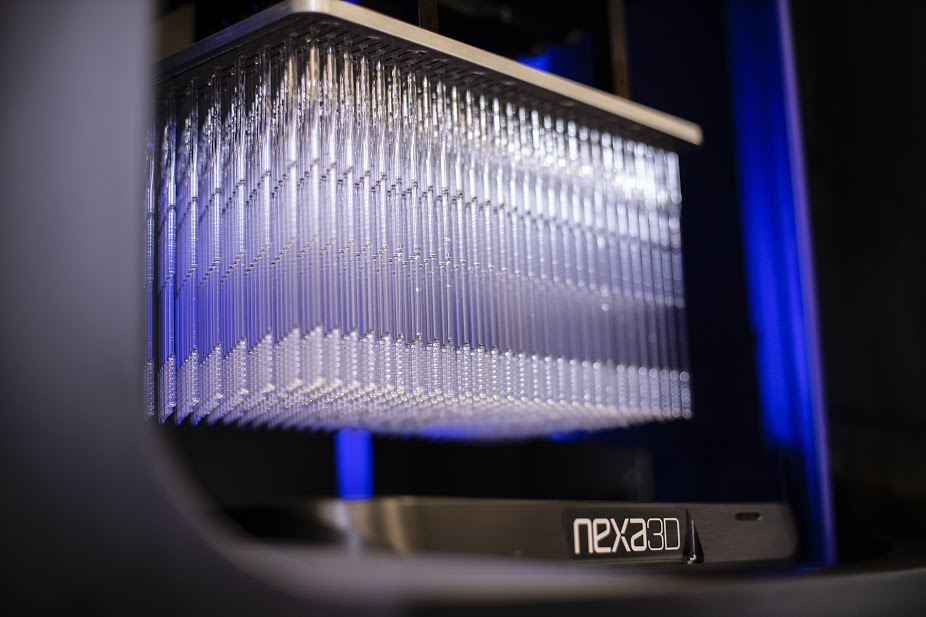reprint from https://3dprintingindustry.com/
California-based SLA 3D printer manufacturer Nexa3D and global chemical company Henkel have launched a new polymer for 3D printing called xMED412.
The polypropylene (PP)-like material combines enhanced strength properties with the biocompatibility of medical-grade materials, potentially making it well-suited to producing medical devices. What’s more, the high-impact, durable plastic has also been tested and cleared by the U.S. Food and Drug Administration (FDA) for use within clinical environments. As a result, the polymer could be used for manufacturing products such as orthotics guides and braces, or even to print nasal testing swabs for COVID-19.
“We are thrilled to bring this product to market in collaboration with Nexa3D,” said Ken Kisner, Henkel’s Head of Innovation for 3D printing. “We developed and tested with Nexa3D’s NXE400 3D printer a multitude of approved workflows designed to unleash the full potential of xMED412’s outstanding physical properties and biocompatibility.”
“WE ARE PLEASED THAT NASOPHARYNGEAL SWABS MANUFACTURED WITH XMED412 ON THE NXE400, IN ACCORDANCE WITH OUR PUBLISHED PROCEDURES, HAVE ALREADY BEEN CLEARED THROUGH CLINICAL TRIALS AND ARE IN COMPLIANCE.”
Henkel and Nexa3D’s ongoing 3D printing partnership
While Nexa3D is better known for its stereolithography (SLA) machines, Henkel has a strong recent track record of developing new plastic 3D printing materials, working with a range of industry partners to accomplish this. While contributing to the SYMPA SLA durability project for instance, the company developed new materials and SLA processes for the automotive sector.
Henkel later signed an agreement with 3D printing marketplace and service bureau Shapeways, to extend its material provisions for large-scale additive manufacturing. As part of the deal, the ‘Loctite powered by Shapeways’ program was founded, which saw the partners begin to offer each other’s services to their customers. This was followed by a deal with German 3D printer manufacturer Rapid Shape, to design new materials for its Digital Light Processing (DLP) systems.
Then, in April 2020, Henkel and Nexa3D started to develop a line of co-branded photopolymer SLA resins, which would be distributed through the latter’s global channels. Leveraging their respective expertise in SLA 3D printing and performance resins, the duo aimed to create functional parts using Henkel’s materials on an NXE400 3D printer. Now, having begun working together just three months ago, the partnership has already yielded two new materials, including xMED412.
“This is our second joint material introduction in as many months with Henkel to develop a portfolio of co-branded performance photopolymers through our expanding global channels,” said Izhar Medalsy, Chief Operating Officer of Nexa3D. “We are continuing to jointly address specific high throughput industrial production opportunities leveraging our leading print speed, large build volume and intelligent resin management technology to convert Henkel performance resins into functional parts made on the NXE400 3D printer.”

Nexa3D and Henkel’s new xMED412 is capable of producing testing swabs for detecting COVID-19. Photo via Nexa3D, Trinity Wheeler Photography.
The new polypropylene-like 3D printing material
Based on Henkel’s Loctite MED412 polymer resin, xMED412 reportedly provides “fantastic” elongation at break, impact strength, and compression toughness. Moreover, the lightweight yet sturdy polymer has inherent insulating properties, allowing it to withstand impact, moisture and vibration changes. These features allow the filament to be used to produce devices that need to be sterilized and disinfected, or be shipped around the world for use in home and healthcare settings.
In addition, for many companies that manufacture single-use medical devices or reusable instruments, they need materials that are able to bend and flex, so that the final part can be used on a patient’s body. Such components need to be pliable, elastic, and often kink-resistant, making xMED412 well-suited to these applications. What’s more, the new material is covered by all of the associated clearances, tests and certifications granted to its predecessor, Loctite MED412.
xMED412 has also been individually tested by Henkel, and was found to be compliant with ISO 10993 testing and FDA Class I safety standards. These validations mean that the company’s polymers can be utilized to create end-use parts for applications within medical settings such as COVID-19 testing swabs. “We are very excited to jointly bring to market with Henkel a second production-grade material, particularly at this time of persisting requirements for PPE and other mission critical devices,” added Medalsy.
Like many 3D printing companies in the U.S, the pandemic has forced Nexa3D to spring into action. In support of the country’s demand for nasal testing swabs, the company quickly qualified and scaled its single printer production capacity within its ‘flexible factory’ to 5,400 swabs a day. Now, using its latest medical-grade material, Nexa3D’s customers are already producing other vital pandemic-related parts such as those for ventilators, among others.
“We are very pleased to see the marketplace’s overwhelmingly positive response to xMED412 parts manufactured on the NXE400 3D printer,” concluded Michele Marchesan, Nexa3D’s Chief Growth Officer. “Customers are printing ventilators and other medical device parts, including venturis and connectors at productivity and scale, which are fast achieving the new standard for flexible series production.”
For more information on Nexa3D please click the button below.
Featured image shows splitters that have 3D printed using Henkel and Nexa3D’s new xMED412 PP material. Photo via Nexa3D, Trinity Wheeler Photography.







Leave A Comment